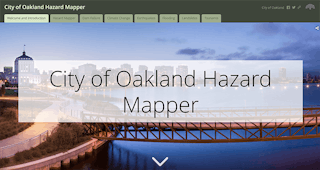Check out Oakland's Hazard Mitigation Story Map website for a visual depiction of the hazards being analyzed as part of the 2021 City of Oakland Hazard Mitigation Plan (HMP).
→ Watch our Video on How to Use the Hazard Risk Story Mapper
On June 15, 2021, the City of Oakland adopted the 2021-2026 Local Hazard Mitigation Plan (LHMP). The LHMP serves as a meaningful guide to increasing the Oakland community’s resilience in the face of natural disasters, such as earthquakes, floods, extreme heat and fires. The City will be engaging with the community in the near future for the development of the 2026 LHMP. The Oakland Fire Department will oversee the plan update process. Please contact the Emergency Management Services Division at emergencyplanning@oaklandca.gov for more information.

Check out Oakland's Hazard Mitigation Story Map website for a visual depiction of the hazards being analyzed as part of the 2021 City of Oakland Hazard Mitigation Plan (HMP).
→ Watch our Video on How to Use the Hazard Risk Story Mapper
The Local Hazard Mitigation Plan (LHMP) strives to inventory potential hazards that the City of Oakland is most vulnerable to, assess risks to the city’s residents, buildings and critical facilities, and develop a mitigation strategy to reduce the risk of exposure and allow a swift and organized recovery should a disaster occur. This mitigation strategy is reflected in an Action Plan. In the past year, the City of Oakland has been busy working efforts to mitigate hazards, including:
Each year, City staff develop a LHMP Annual Progress Report describing the progress on the LHMP Action Plan. Our 2024 LHMP Annual Progress Report was open for public comment between May 13 – May 28, 2024, the public comment period is now closed. However, you are welcome to contact emergencyplanning@oaklandca.gov with questions and concerns. To learn about communities preparing for disaster visit: Ready Oakland
This plan strives to inventory potential hazards that the City of Oakland is most vulnerable to, assess risks to the city’s residents, buildings and critical facilities, and develop a mitigation strategy to reduce the risk of exposure and allow a swift and organized recovery should a disaster occur.
The hazards that the LHMP addresses include:
In 2021, the City of Oakland updated its 2016-2021 Local Hazard Mitigation Plan (LHMP). The Plan update was a requirement to maintain FEMA funding eligibility. The updated Plan helps guide the City and its partners to implement these strategies throughout Oakland. This 2021 plan will remain active until 2026.
All project updates will be posted to this website so that you can easily find and engage with the information that matters to you.
Steering Committee Meetings
Get More Info
Hashtags
#ReadyOakland
#OFD
*Please use these hashtags when sharing information about the LHMP on social media

Sign up for email updates using this link or scan the QR code at the right.
The Disaster Mitigation Act of 2000 (DMA) requires local governments to adopt a federally approved Multi-Hazard Mitigation Plan in order to receive pre- and post-disaster mitigation funds from the Federal Emergency Management Agency's (FEMA) Hazard Mitigation Grant Program. The DMA emphasizes planning for disasters before they occur.
For more information about FEMA funding tied to an active/updated Hazard Mitigation Plan, visit FEMA's website.
MISSION STATEMENT
To equitably reduce risk and increase resilience, the mission of the City of Oakland Local Hazard Mitigation Plan is to establish and promote a comprehensive mitigation strategy and efforts to protect the Whole Community and environment from identified natural and manmade hazards.
GOALS
OBJECTIVES
Was this page helpful?
Report a problem with this page